NCERT Solutions for Class 4 Maths Chapter 8 - Weigh It, Pour It
| Table of contents |

|
| Page 115 |

|
| Page 116 |

|
| Page 117 |

|
| Page 118 |

|
| Page 119 |

|
| Page 120 |

|
| Page 121 |

|
| Page 122 |

|
| Page 123 |

|
| Page 124 |

|
| Page 125 |

|
| Page 126 |

|
| Page 127 |

|
Page 115
Weigh It, Pour It
Q1: Look at the pictures given and write the names of the animals from heaviest to lightest.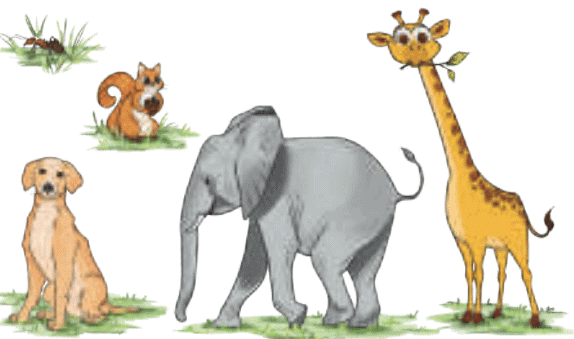
Ans: Elephant > Giraffe > Dog > Squirrel > Ant
Q2: Write the name of the heaviest object in your home. How did you know?
Ans: Example: Fridge. Known by estimating or lifting, it feels much heavier than other objects like chairs or tables.
Q3: Do you carry your school bag with ease or with some effort?
Ans: With some effort (depends on bag weight, typically 2–5 kg for Class 4 students).
Q4: Write the name of the heaviest book in your bag. How did you know?
Ans: Example: Maths textbook. Known by comparing books; it feels heavier or looks thicker.
Q5: What is your weight? How did you know?
Ans: Example: 25 kg. Known by using a weighing scale at home or school.
Fun at Vegetable Market!
Rita and Shabnam went to the market to buy some fruits and vegetables. They saw the vegetable seller weighing vegetables.
Q: What do you think will be the weight of the half pumpkin?
Ans: A whole pumpkin is typically 2–5 kg. Half a pumpkin: ~1–2.5 kg (e.g., half of 4 kg = 2 kg). Verify with a scale.
Page 116
Let Us Do
Q: Estimate the weight of the following and put a tick mark (✓) in the appropriate cell. Verify with a weighing balance.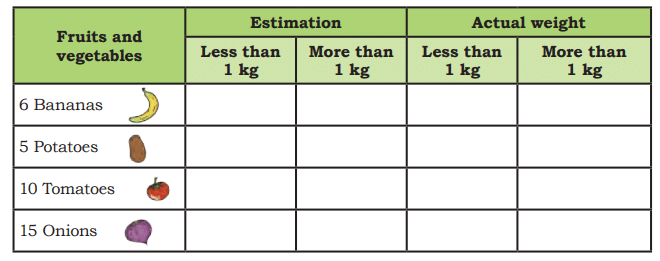
Ans: 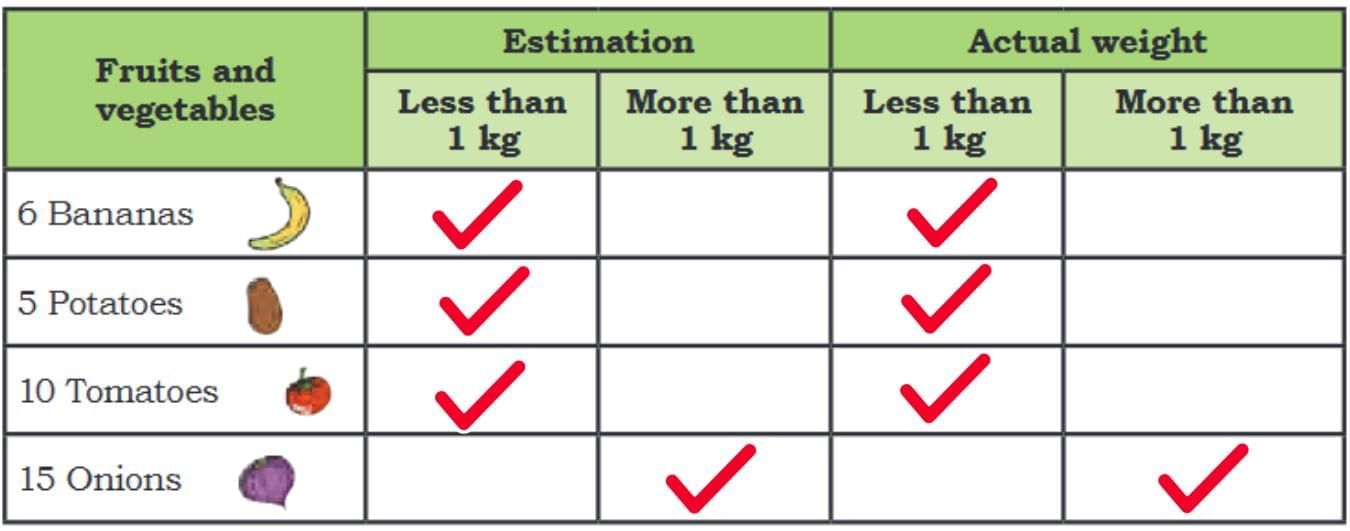
Page 117
Let Us Find
Q1: How many 250 g daal packets will balance one 500 g daal packet? Draw as many packets of 250 g on the empty pan to balance the 500 g packet. What did you find? 250 g = ___ of 500 g (½, 2).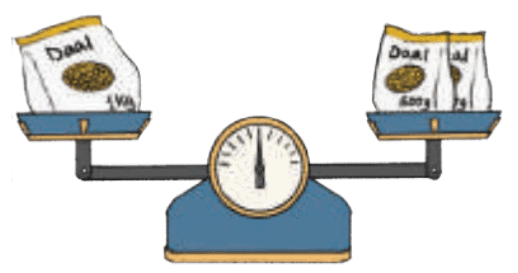
Ans:
- 500 g ÷ 250 g = 2 packets of 250 g.
- Draw 2 packets of 250 g on the empty pan to balance.
- Ans: 250 g = ½ of 500 g.
Page 118
Let Us Find
Q2: Draw arrows to indicate which side the pan balance will tilt?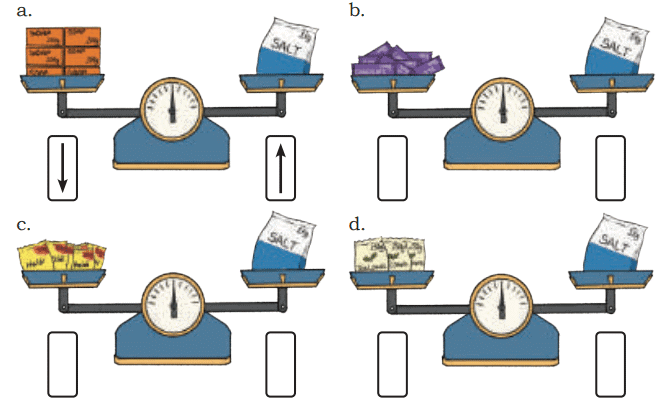
Ans: 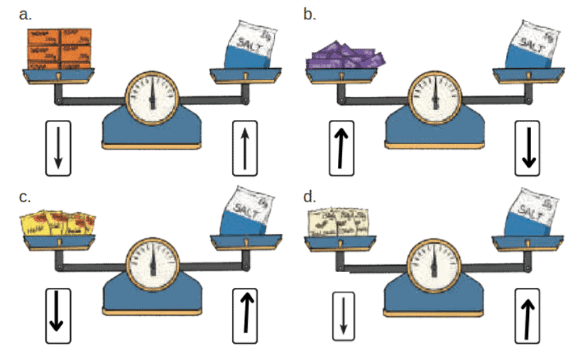
Q3: Match the unit convenient for measuring each of the following objects?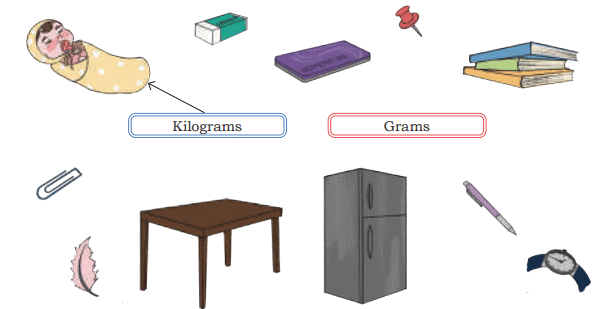
Ans: 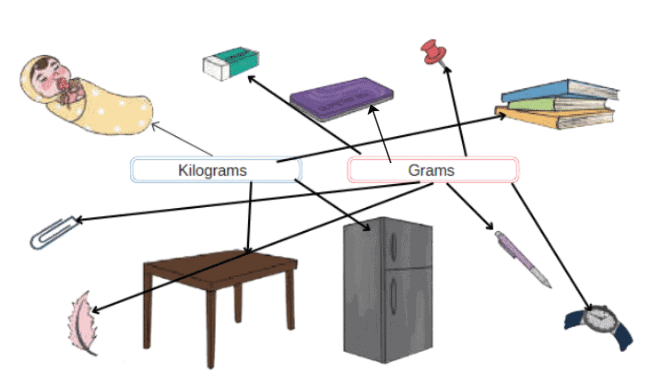
Page 119
Let Us Do

Q1: How many erasers will weigh the same as a 50 g Haldi packet?
Ans: Assume an eraser weighs ~10 g. 50 g ÷ 10 g = 5 erasers.
So, 5 erasers will weigh equal to a 50 g Haldi packet.
Q2: A 100 g soap bar will weigh the same as ___ erasers.
Ans: 10 g = 1 eraser
⇒ 100 g = 10 × 10 g = 10 × 1 eraser = 10 erasers
So, 100 g soap bar will weigh the same as 10 erasers.
Q3: ___ erasers will weigh the same as 250 g sugar.
Ans: 10 g =1 eraser
⇒ 250 g = 25 × 10 g = 25 × 1 eraser = 25 erasers
So, 25 erasers will weigh the same as 250 g of sugar.
Page 119
Let Us Think (Boxes of Sweet)
Mr Shrinathan, a sweet shop owner, has several orders for 1 kg Kaju-katli but he has to pack them in different sized boxes.
Write the number of boxes needed to pack 1 kg Kaju-katli in the blank space:
1. Mr Das wants the sweets in boxes weighing 500 g each.
Ans: Since 1 kg = 1000 g
= 500 g + 500 g = 2 × 500 g
So, Mr Shrinathan needs 2 boxes of500 g each to pack 1 kg Kaju-Katli.
2. Mrs Fernandes wants the sweets in boxes weighing 250 g each.
Ans: Since 1 kg = 1000 g
= 250 g + 250 g + 250 g + 250 g = 4 × 250 g
So, Mr Shrinathan needs 4 boxes of250 g each to pack 1 kg Kaju-Katli.
3. Mrs Khan wants the sweets in boxes weighing 100 g each.
Ans: Since 1 kg = 1000 g
= 100 g + 100 g + 100 g + 100 g + 100 g + 100 g + 100 g + 100 g + 100 g + 100 g
= 10 × 100 g
So, Mr Shrinathan needs 10 boxes of 100 g each to pack 1 kg Kaju-Katli.
4. Mr Patel wants the sweets in boxes weighing 50 g each.
Ans: Since 1 kg = 1000 g
= 10 × 100 g
= 10 × (2 × 50 g)
= 20 × 50 g
So, Mr Shrinathan needs 20 boxes of 50 g each to pack 1 kg Kaju-Katli.
Page 120
Weighing Machines
Do you know the different types of weighing machines used to weigh different objects?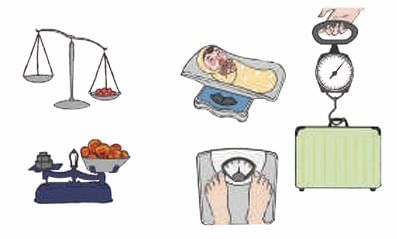
Ans: Do it Yourself!
Q: Ask your parents and find the amount of consumption of the following items at your home in a month.
Ans: Example (varies by household): 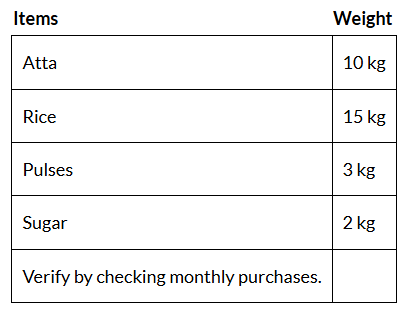
Taran and his sister are lifting packets of flour, rice, and salt.
What do you think they are experiencing while lifting these packets? Have you ever lifted such packets at your home? What do you experience? Discuss.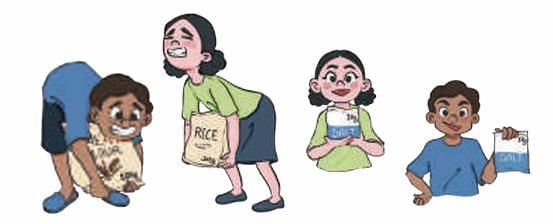
Ans: They feel effort while lifting heavy packets (e.g., 5 kg flour is harder than 1 kg salt).
Personal experience: Lifting 5 kg rice feels heavy, requires both hands; 1 kg salt is easier.
Discuss: Heavier packets strain arms, lighter ones are manageable.
Page 121
Let Us Do
Q1: Try to lift some objects around you and write the names of three objects that you can lift easily. Estimate and write their weights.
Ans:
- Pencil: ~10 g
- Notebook: ~200 g
- Water bottle: ~500 g
Q2: Now write the names of things that you can lift with a lot of effort. Estimate and write their weights.
Ans:
- School bag: ~3 kg
- Chair: ~5 kg
- Bucket of water: ~10 kg
Q3: How many 1 kg packets are in:
a. 10 kg
Ans: 10 kg = 10 × 1 kg
There are 10 packets of 1 kg each in 10 kg.
b. 20 kg
Ans: 20 kg = 20 × 1 kg
There are 20 packets of 1 kg each in 20 kg.
c. 50 kg
Ans: 50 kg = 50 × 1 kg
There are 50 packets of 1 kg each in 50 kg.
d. 25 kg
Ans: 25 kg = 25 × 1 kg
There are 25 packets of 1 kg each in 25 kg.
Q4: Match the objects in the left column with their estimated weights in the right column.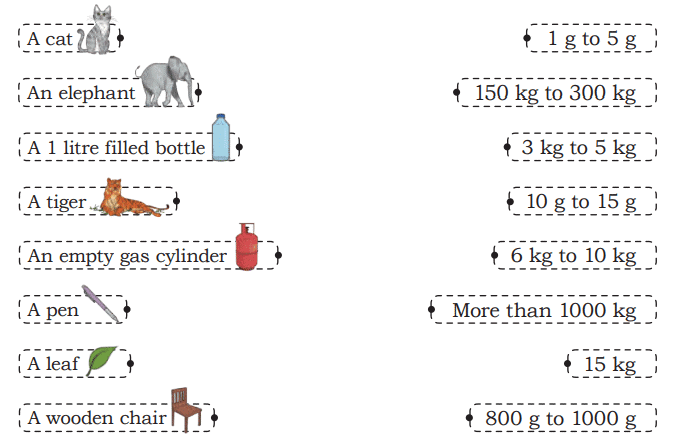
Ans:
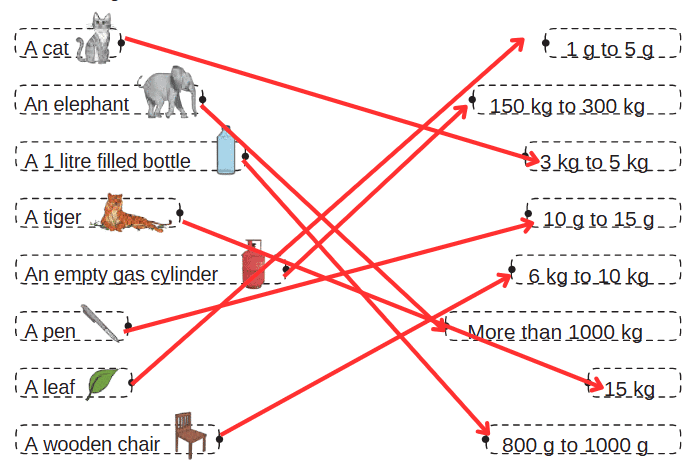
Page 122
Measuring Capacity
Q: Do you remember the 1 litre bottle? How much water does your water bottle hold?
Find bottles and containers that can hold the following quantities of water.
Ans: Example: My water bottle holds 1 litre. 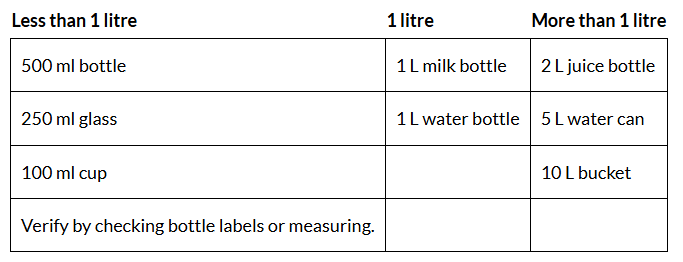
Page 123
Let Us Find
a) How many 500 ml bottles will fill a 1 l bottle?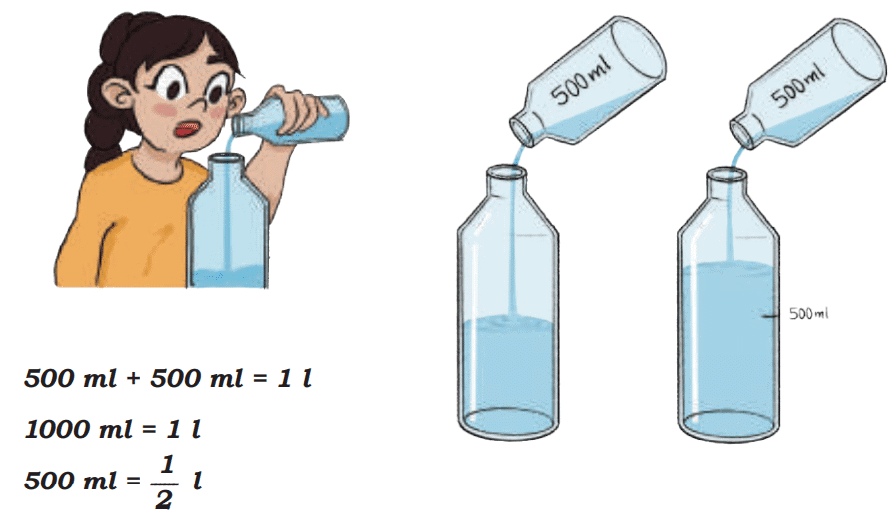
Ans: Since 11 = 1000 ml = 500 ml + 500 ml
= 2 × 500 ml
Thus, two 500 ml bottles will fill a 1 l bottle.
b) How many 250 ml bottles will fill a 1 l bottle?
Ans: Since 1 l = 1000 ml
= 250 ml + 250 ml + 250 ml + 250 ml
= 4 × 250 ml
Thus, four 250 ml bottles will fill a 1 litre bottle.
c) How many 100 ml bottles will fill a 1 l bottle?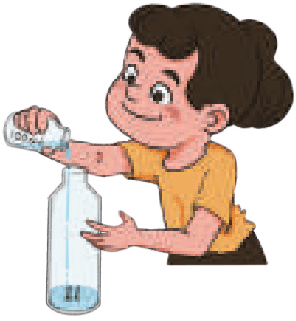
Ans: Since 11= 1000 ml
= 100 ml + 100 mlm + 100 ml + 100 ml + 100 ml + 100 ml + 100 ml + 100 ml + 100 ml + 100 ml
= 10 × 100 ml
Thus, ten 100 ml bottles will fill a 1 l bottle.
d) How many
Ans:
1/2 l = 1/2 × 1000 ml = 500 ml
= 250 ml + 250 ml
= 2 × 250 ml
So, there are two 250 ml in 12 l.
750 ml = 250 ml + 250 ml + 250 ml
= 3 × 250 ml
So, there are three 250 ml in 750 ml.
1/2 l = 1/2 × 1000 ml = 500 ml
= 100 ml + 100 ml + 100 ml + 100 ml + 100 ml
= 5 × 100 ml
So, there are five 100 ml in 12 l.
800 ml = 100 ml + 100 ml + 100 ml + 100 ml + 100 ml + 100 ml + 100 ml + 100 ml
= 8 × 100 ml
So, there are eight 100 ml in 800 ml.
Page 124
Let Us Do
Q1: Find a dosing cup or a bottle of 10 ml and try to find how many 10 ml will fill a 100 ml bottle __________________
Ans: 100 ml = 10 × 10 ml
So, ten 10 ml cups will fill a 100 ml bottle.
Find how many 10 ml dosing cups will fill:
a) 250 ml glass
Ans: 250 ml = 25 × 10 ml
So, 25 dosing cups of 10 ml will fill a 250 ml glass.
b) 500 ml vessel
Ans: 500 ml = 50 × 10 ml
So, 50 dosing cups of 10 ml will fill a 500 ml vessel.
c) 1 l bottle
Ans: 1 l = 1000 ml = 100 × 10 ml
So, 100 dosing cups of 10 ml will fill a 1 l bottle.
Q2: Take a 1 ml dropper and find out: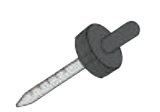
a) How many 1 ml droppers will fill a 10 ml dosing cup?
Ans: 10 ml ÷ 1 ml = 10 droppers
b) How many droppers will fill a teaspoon?
Ans: A teaspoon is ~5 ml. 5 ml ÷ 1 ml = 5 droppers
Q3: Find out how much of these liquids are used at a time:
a) Eye drops
Ans: Less than 1 ml (e.g., 0.05 ml per drop)
b) Honey
Ans: ~5–15 ml (1–3 teaspoons)
c) Cough Syrup
Ans: ~5–10 ml (per dose, check label)
d) Cooking Oil
Ans: ~15–30 ml (1–2 tablespoons per dish)
Page 125
Let Us Do
Q4: Mr Krishna packages perfumed oils in different sized bottles. During a festival, the following customers asked for 1 l perfumed oils but in different sized bottles. Write the number of bottles each of them will get.
a) Ms Shetty wants bottles of 500 ml each
Ans: 1 l = 1000 ml = 500 ml + 500 ml
So Mr Krishna needs two 500 ml sized bottles.
b) Mr Muthukumar wants bottles of 200 ml each
Ans: 1 l = 1000 ml = 200 ml + 200 ml + 200 ml + 200 ml + 200 ml
So, Mr Krishna needs five 200 ml sized bottles.
c) Ms Naini wants bottles of 100 ml each
Ans: 1 l = 1000 ml = 10 × 100 ml
So, Mr Krishna needs ten 100 ml sized bottles.
d) Ms Kannan wants bottles of 50 ml each
Ans: 1 l = 1000 ml = 20 × 50 ml
So, Mr Krishna needs twenty 50 ml sized bottles.
Q5: Estimate and verify by measuring. Use the bottles you have collected for this purpose (for example, 500 ml, 250 ml, 100 ml, 50 ml, and 10 ml).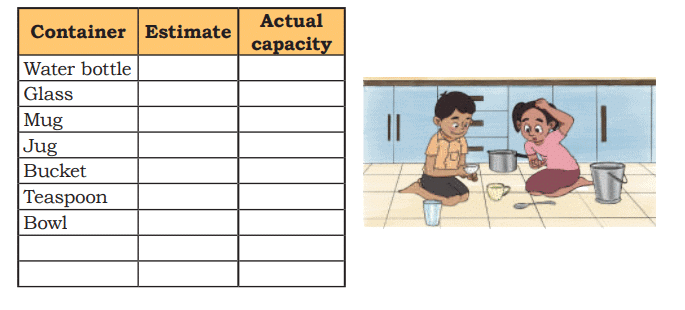
Ans: 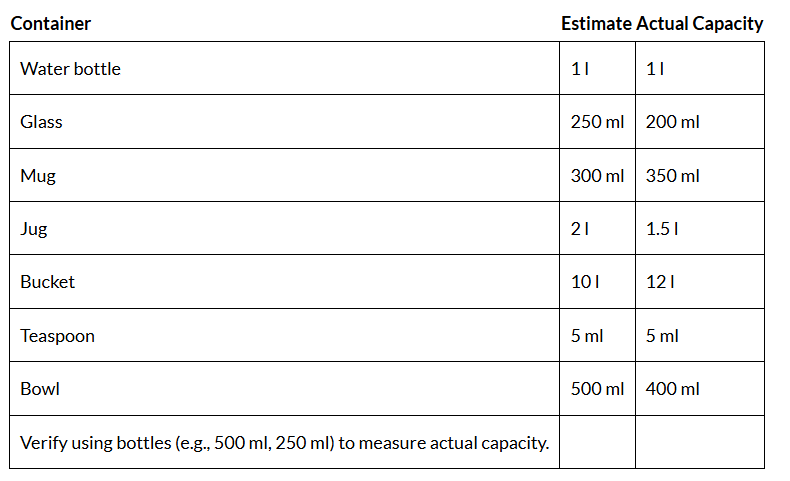
Page 125
Let Us Explore
Q: Visit nearby shops and make a list of different items that are sold in the following quantities.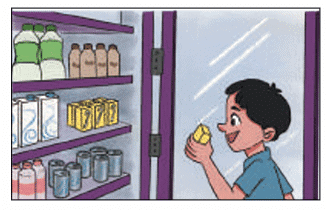
Ans: 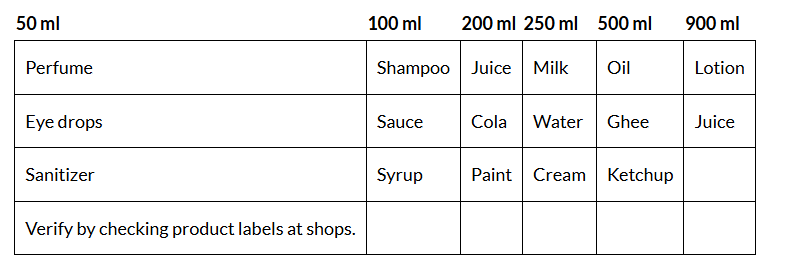
Page 126
Let Us Find
a) How many litres of water do you drink in a day? How did you find out?
Ans: ~1–2 litres. Found by counting glasses (e.g., 4 glasses × 250 ml = 1 litre).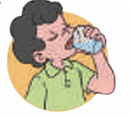
b) How much water can a crow drink at a time?
Ans: ~10–20 ml (based on small beak capacity).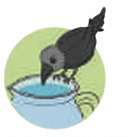
c) How much milk do you drink in one day?
Ans: ~200–500 ml (e.g., 1–2 glasses of 200 ml).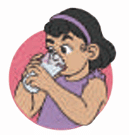
d) How much water does an elephant drink in a day?
Ans: ~100–200 litres (based on known elephant consumption).
Q: What do you use the most water for? What do you use the least water for? Compare this with a few others in your grade . In which activities is your water usage the same?
Ans:
- Most: Bathing (~20–50 litres)
- Least: Drinking (~1–2 litres)
Compare: Most classmates use similar amounts for bathing; drinking varies slightly.
Q: How much water may be used in the following activities?
a. Water for taking a shower
Ans: ~20–50 litres (bucket bath or 5–10 min shower)
b. Watering crops in a field
Ans: ~1000–5000 litres (depends on field size)
c. Watering flowering plants
Ans: ~1–5 litres per plant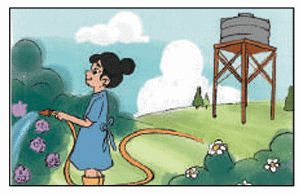 d. Washing clothes
d. Washing clothes
Ans: ~20–100 litres (manual or machine wash)
Page 127
Water Conservation in Everyday Life
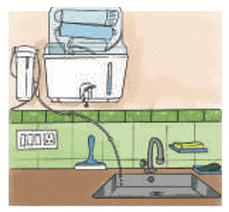 Take a container and put it under a leaking tap for an hour. How much water is lost in an hour? Did it surprise you?
Take a container and put it under a leaking tap for an hour. How much water is lost in an hour? Did it surprise you?
Ans: ~100–500 ml (slow drip, e.g., 1–5 ml per minute). Surprising as small drips add up significantly.
Q: How much water is lost in a day?
Ans: If water drips slowly and fills about 1 glass (250 ml) in an hour, then:
In a day (24 hours) → 250 ml × 24 = 6,000 ml = 6 liters
About 6 liters of water can be lost in one day from a slow drip.
Q: How much water is lost in a week?
Ans: If 6 liters are lost in a day, then in 7 days:
6 liters × 7 = 42 liters
Around 42 liters of water can be wasted in one week.
Q: How would this wastage of water affect us?
Ans: Wasting water means we will have less clean water to use for drinking, bathing, cooking, and growing food. It can also lead to water shortages in the future. We should save water because it is very precious.
|
54 videos|186 docs|14 tests
|
FAQs on NCERT Solutions for Class 4 Maths Chapter 8 - Weigh It, Pour It
| 1. What is the importance of weighing and measuring in everyday life? |  |
| 2. How can we measure capacity using different tools? |  |
| 3. What are some common units of weight and capacity? |  |
| 4. How can children learn to weigh and measure effectively? |  |
| 5. What are the benefits of using weighing machines in stores? |  |




















